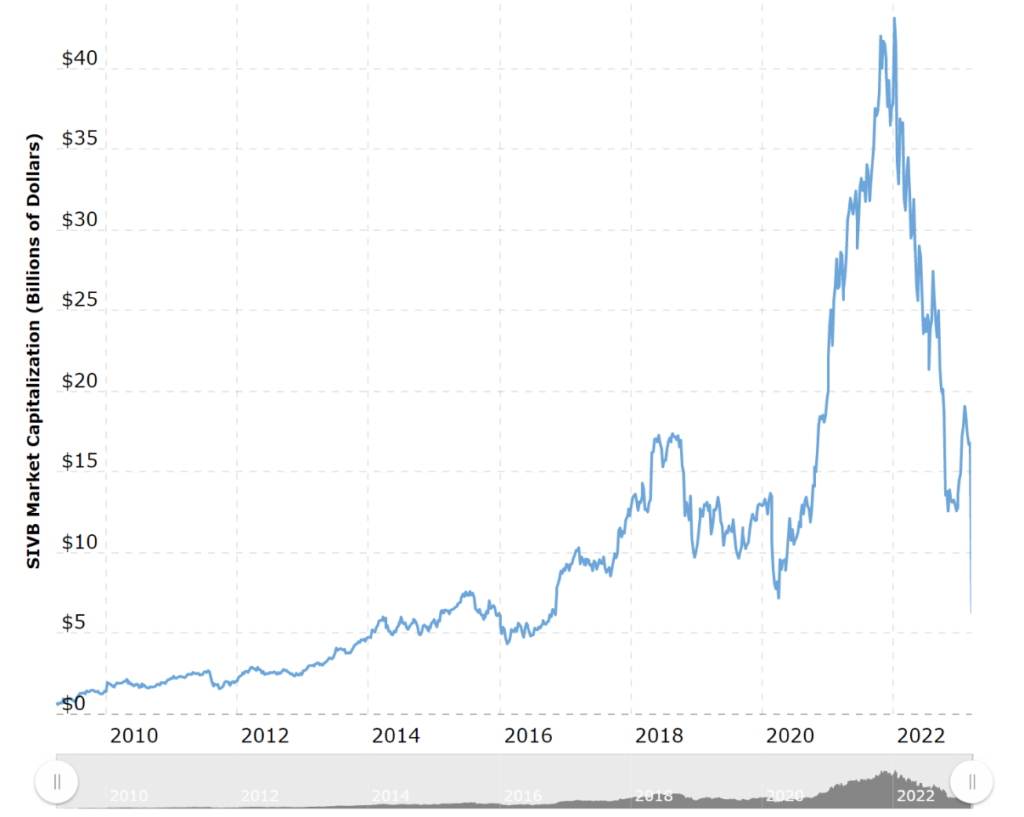SVB's Collapse -
3 Lessons for us (investors)
1) Don’t mix money buckets
2) Hold a healthy rainy day fund
3) Manage risk via diversification
The four most expensive words in the English language are, ‘This time it’s different.
(Sir John Templeton)
Friday, March 10, started out like most Friday mornings. I was sitting at my desk; sipping coffee; grateful for yet another sunny day (Hey, it’s the PNW!) and the week coming to a close; casually scanning headlines from my favorite news sites. I noticed that a story from the day before about regional bank, Silicon Valley Bank (SVB), trying to raise money to meet depositors’ withdrawals, had escalated. Of course, I checked SVB’s stock price and saw that it had dropped a stomach churning 60% since the market opened that day. (Yikes!)
Like witnessing a train wreck, I spent much of the day checking headlines, the stock market and Twitter feeds of seasoned investors/economists I liked and followed (informally). By day’s end, SVB had collapsed. It was the second biggest bank failure since Washington Mutual (WAMU – 2008). As noted in the press, this collapse was reminiscent of Fall 2008 when storied financial institutions found themselves in great distress and some disappeared seemingly over night: Lehman Brothers (failed); Washington Mutual (failed); Merrill Lynch (bought out); Bank of America (bailed out); Goldman Sachs (bailed out). (Déjà vu!)
So, why did SVB fail?
Based in the Bay Area, SVB’S core clientele were tech and venture capital firms. SVB benefited greatly from a low interest/low inflation world, because its clients had benefited greatly from cheap money. During the pandemic, SVB was flushed with cash deposits from its tech clientele. In the then low-yield world, like many investors, SVB tried to eke out higher returns by investing depositors’ money into long-term bonds.
Beginning March 2022, the Fed began raising interest rates aggressively (from 0% to 4% within a year’s time) to fight high inflation. As a result, SVB’s long-term bonds started to lose money at the same time when its depositors were running low on cash and so had to make withdrawals. (Perfect storm!) When SVB sold long-term bonds (at a loss) to meet withdrawals, it triggered a bank run fueled by technology (think Twitter…ironic). Depositors tried to withdraw $42 billion in one day! This sent SVB’s stocks into a tailspin. (See graph below of SVB’s market capitalization.) Within 2 days, the bank went bankrupt. To stem a possible domino effect, the government promised to repay all depositors, including those with deposits over the FDIC-insured amount $250,000, their money.
SVB’s Market Capitalization (2010 – 2023)

Source: Macrotrends “SVB Financial Group Net Worth 2010-2023”
What lessons does SVB’s failure hold for us (investors)?
Some have labeled SVB the canary in the coal mine. Personally, I see it as a modern-day financial parable. What lessons can we learn from it? What steps can we take now to strengthen our own financial house, regardless of what the Fed has done or will or will not do moving forward?
LESSON 1: Don’t mix your money buckets.
SVB took money from their short-term fund set aside to meet depositor’s withdrawals and invest it in long-term bonds. When interest rates went up quickly and aggressively, SVB long-term bonds lost money in the short-term and so it struggled to meet depositors’ panicked withdrawals of cash.
When managing money, it’s important to separate our buckets according to when we may need it. The higher the likelihood of needing the money in the short-term, the more liquid and “safe” a place we should keep it. The higher the likelihood of needing the money in the long-term (10+ years), the less liquid the money needs to be and so can be invested in the market for potentially higher returns. In so doing, we align our cash needs with our investment horizons. (Below is a quick and dirty overview of the “typical” money buckets for the short-, mid- and long-term.)
|
Money Buckets – Short-, Mid- and Long-term |
||
|
Time Period |
Potential Use/Need |
Potential Assets |
|
Short-term |
Emergency fund: Home repair, car repair, medical copay, etc. |
High-yield savings account (very liquid) |
|
Mid-term |
Car purchase, home purchase/down payment, home repair/renovation, travel, etc. |
CD ladder: 1-, 2-, 3-year |
|
Long-term |
Retirement, college education |
Stocks and bonds |
LESSON 2: Hold a healthy rainy-day fund, because rain will eventually come.
When flushed with cash, rather than set aside an adequate rainy-day fund to meet potential withdrawals, SVB tied it up in riskier assets. Unfortunately, when the economic weather turned, SVB was caught in the rain without an “umbrella.”
Although it’s impossible to predict with consistency and accuracy the next economic “downpour,” it’s important to remember that there will be one. So, regardless of how sunny the weather has been, it’s critical that we set aside some cash. REASONS: 1) Cash is now earning a reasonable return (3-5%) for little, or no, risk 2) Cash helps us weather through economic storms 3) Cash helps us continue to hold our investment portfolio as its value drops 4) Cash gives us the option of buying assets should they become cheaper.
LESSON 3: Return is a by-product of how well we manage/control risks. (Diversification is critical.)
Since SVB’s core clientele was in tech, its risk was closely tied to that sector. The bank further increased its risk by diversifying into long-term bonds.
Over the past decade, as investors, we’ve enjoyed a great run from US stocks, especially the growth segment. Given this run-up, US stocks are (still) relatively expensive. As is, now may be a good time to diversify further into safer cash and cheaper investments.
Safeguard your cash: Given the growing uncertainty within banking and the increased importance of cash, consider doing the following:
· STEP 1: Make sure that your bank (accounts) is FDIC-insured ($250,000 per depositor) – Check HERE. REASON: Get your total deposits back should your bank(s) fail.
· STEP 2: If your total deposit with one bank exceeds $250,000, then consider moving half of it to another bank. REASON: Increase your FDIC-insured amount from $250,000 to $500,000 to cover your total deposits.
· STEP 3: Consider diversifying your emergency fund (savings account) further, regardless of amount, by depositing half of balance with another FDIC-insured bank that offers highish interest. REASON: Should one of your banks fail, you would still have access to some your emergency fund.
Make sure that you hold a balanced, diversified portfolio. As mentioned, the US stock market, especially the growth segment, has had an incredible run over the past decade. So, it’s likely that many portfolios are still tilted towards US market > growth, which remains the most expensive. Consider rebalancing your portfolio by selling some US (growth) stocks and putting proceeds into US value and international stocks. Diversification offers the dual benefits of lowering risks while potentially increasing returns. (Free lunch!)
Final thoughts…
SVB’s fate is more or less settled. That of the US and global economy remains less clear. The Fed and other global central banks’ aggressive raising of rates may have likely created a ripple effect that’s still unfolding. Risks are a part of life. Although it is expensive, if not impossible, to mitigate all risks, there are steps we can take now to protect ourselves from getting caught in a potential (economic) downpour. Faced with uncertain times, it’s important to remember that all times are uncertain. Also, if we can’t avoid the downpour, then the next best thing is to try and survive it…because all storms do eventually pass.
RECENT POSTS
March 2025
Although 2024 double-digit stock market return suggests a strong US economy, the recent change in government leadership and policies highlights the underlying risk (uncertainty) that now weighs down the market and tests American exceptionalism.
December 2024
The fifth anniversary of my advisory firm and the holiday season have prompted me to reflect on my Life’s journey so far and, in so doing, unexpectedly arrive at an unconventional perspective on gifting.
October 2024
August steep market decline serves as a useful dress rehearsal for how we might react in a bear market and what we should do now to increase survival.
Get a free financial education.
Learn more about key financial topics, such as investing, 401k, disability insurance, paying for a home, at your own convenience. Sign up for Women’s Wealth monthly newsletter and have relevant information delivered to your inbox.

Live life on your own terms.
Do you find yourself constantly stressed or bored at work and wondering when you can live life on your own terms? Learn how to harness money’s energy and begin to create your life rather than manage it.
CONNECT
Anh Thu Tran
Women’s Wealth LLC
P.O. Box 1522
Tacoma, WA 98401
anhthu@womenswealthllc.com
(206) 499-1330
Women’s Wealth LLC is a Washington State registered investment advisor. The presence of this website on the Internet shall not be directly or indirectly interpreted as a solicitation of investment advisory services to persons of another jurisdiction unless otherwise permitted by statute. Follow-up or individualized responses to consumers in a particular state by our firm in the rendering of personalized investment advice for compensation shall not be made without our first complying with jurisdiction requirements or pursuant an applicable state exemption. For information concerning the status or disciplinary history of a broker-dealer, investment advisor, or their representatives, a consumer should contact their state securities administrator.
© 2021 Women’s Wealth LLC. All rights reserved. | Design by Erin Morton Creative, LLC.



